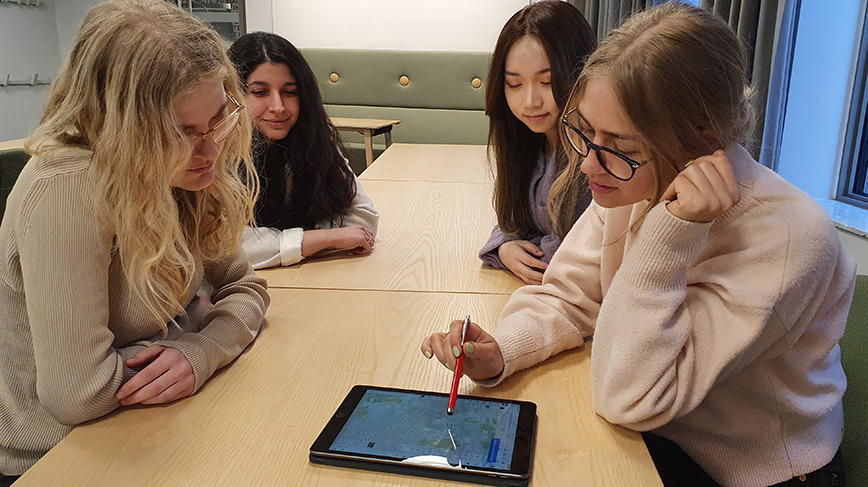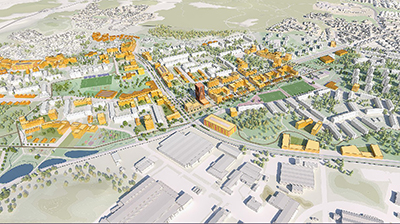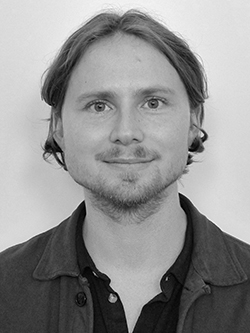Students advise city on its plans to reverse neighborhoods’ isolation

Social and physical segregation are two of the problems one Swedish city hopes to reverse with a little help from students at KTH.
Planners with Eskilstuna municipality have called on students in the course, Urban Development and Planning, to help flesh out plans the city has adopted for redeveloping three neighborhoods that have tenuous connections to the rest of the city, in terms of both social interaction and physical access.
Eskilstuna’s project leader Robert Gremalm says the city calls its development strategy “urban healing”.
“For these neighborhoods, urban healing is about bringing the communities closer together and creating better links to the rest of the city,” Gremalm says. “It’s about developing quality public space, sustainable infrastructure and diversified housing.”

Gremalm says he was excited to draw on the creativity and multi-disciplinary rigor that student researchers apply to city planning challenges.
In the Eskilstuna project, the KTH students formed small teams and chose which part of the development plan they would address, says the teacher of the course, Peter Brokking.
Vulnerable neighborhood
For some, it was the challenge of integrating the development of new multi-unit housing amid an affluent detached-housing tract just beyond the urban grid. Other teams turned their attention to the southwest corner of the city limits, where the city wants to diversify housing, while improving public space in neighboring multi-unit developments that have been added to the national list of “vulnerable” areas—currently beset by safety issues, low income and social isolation from the rest of Eskilstuna.

With a limited amount of time, Brokking says he wasn’t expecting the students’ proposals to deliver “revolutionary” impact. “It’s more important for them to have a learning experience,” he says, “to understand the challenge the city is faced with and to experience working with the different actors in this.”
At the planning department in Eskilstuna, Gremalm was nevertheless impressed with the proposals, saying that the ideas will be explored further as the city’s planners approach decision time for each of the projects.
Explore value of existing space
In one team, Shuming Rao, Moa Ribjer, Moa Holmqvist and Helin Celep explained how the group addressed the isolation and vulnerability of the multi-unit housing area, named Fröslunda, Råbergstorp and Lagersberg, which has been segregated virtually from its beginnings. They were meant to be surrounded by greenspace, which today presents an unforeseen problem: these spaces are unstructured and offer little to the families living there.
“People don’t feel safe there,” Celep says. “There are no eyes on the streets or parks. So it is a good place to do bad things.”
Data-based approach
Drawing on reams of data the team collected, Ribjer adds: “The crime trends there are relatively recent, and we wanted to draw upon that before it gets stuck.”
Their proposal focused on the physical spaces’ potential value to youngsters and women, and they recommended building outdoor and indoor mixed sports facilities, sheltered picnic areas to bring people together and establishing an area for neighbors to grow their own produce and stage international food festivals on a regular basis.
Ribjer says the project opened a view into the roles of public and private players when it comes to management of public space. “We had some seminars about how municipalities have gone from a more public perspective to a private perspective,” she says. “For me that has been interesting to see how those two perspectives are combined.”
Praise from City
Gremalm lauded all of the teams’ proposals for their attention to detail and analytical substance.
“The students looked at our goals for 2030 and they performed a thorough demographic and economic analysis. They also included climate goals and recommended infrastructure to support these,” he says. “What they delivered was creative and bold thinking, and they presented it in a very clear, pedagogical way, which is what I like.
“They did great work.”
David Callahan
